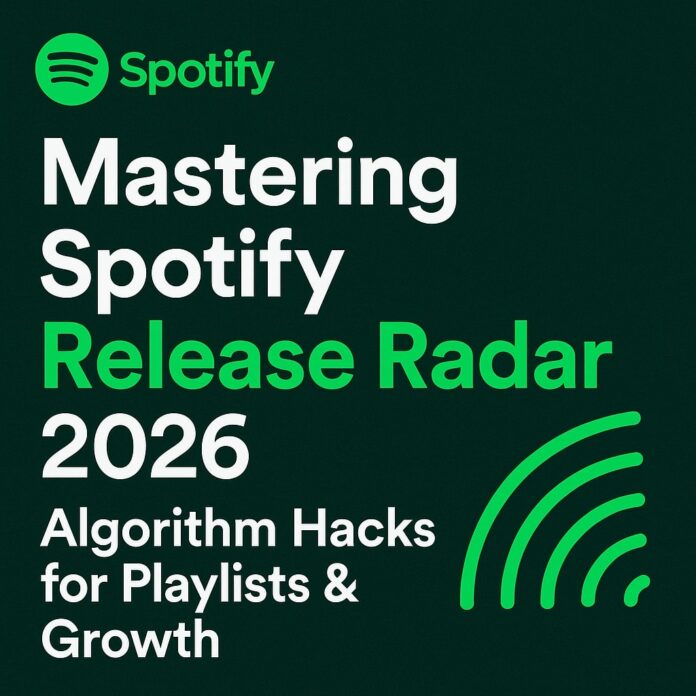
Mastering the Release Radar: Spotify’s Algorithm in 2026
For independent artists and labels, Spotify’s algorithm remains one of the most powerful tools for music discovery in 2026. Playlists like Release Radar and Discover Weekly are not only key drivers of streams but also gateways to sustainable fan growth. While editorial playlists curated by Spotify’s team still matter, the real long-term impact comes from cracking the algorithm. Here’s how to optimize your release strategy and metadata to maximize your chances of landing in high-impact algorithmic playlists.
Why Release Radar Still Matters in 2026
Release Radar is personalized for each listener, meaning that every fan who follows you has a chance to hear your new track within the first week of release. Unlike editorial playlists, Release Radar doesn’t require direct approval from Spotify’s team—it’s fueled by your relationship with fans, your metadata, and listener behavior.
The algorithm rewards:
- Consistent releases (showing Spotify that you’re active and relevant).
- Strong engagement in the first 48 hours (saves, playlist adds, shares).
- Clean metadata and genre tagging (ensuring your music is placed with the right audience).
Pitching to Spotify’s Editorial Team in 2026
Yes, editorial playlists are still important. Submitting your track through Spotify for Artists remains a must. Here are the updated best practices:
- Pitch early: Submit at least 7–10 days before release.
- Focus on storytelling: Editorial curators look for cultural hooks, press coverage, or fan stories.
- Geo-targeting matters: Local playlists are often easier entry points than global ones.
Even if your track isn’t chosen for an editorial playlist, the data from your pitch (genres, moods, instruments) informs Spotify’s algorithm.
Playlist Pitching via ArtistRack.com
In addition to pitching directly through Spotify for Artists, playlist pitching through trusted third-party platforms like ArtistRack.com has become a key strategy for 2026. ArtistRack connects your music with targeted independent playlist curators, helping you generate the early engagement signals (playlist adds, saves, and streams) that Spotify’s algorithm loves.
Well-placed independent playlist features can:
-
Boost your track’s initial momentum within the crucial first 48 hours.
-
Trigger Release Radar and Discover Weekly more reliably by showing strong listener activity.
-
Build long-term playlist traction beyond a one-week editorial push.
Many artists use ArtistRack campaigns in parallel with their editorial submissions to maximize exposure and algorithmic impact.
Optimizing Track Data for Algorithmic Playlists
Landing in Release Radar or Discover Weekly in 2026 comes down to data hygiene and fan activity. Here’s what you need to focus on:
- Metadata Accuracy
– Use precise genre and sub-genre tags. Spotify has refined micro-genres, so specificity matters.
– Include mood descriptors (e.g., “uplifting,” “dark pop”) to help the algorithm understand context. - Engagement Metrics
– Encourage pre-saves: They signal demand before release day.
– Push fans to add your track to their personal playlists—algorithm gold.
– Direct traffic from socials to Spotify in the first 48 hours. - Consistency in Releases
– Regular singles (every 4–8 weeks) perform better in algorithmic feeds than sporadic albums.
– Use EP rollouts to keep momentum flowing. - Fan Retention Signals
– High repeat listens show Spotify that your track resonates.
– Minimize skip rates by front-loading hooks in the first 30 seconds.
The Future of Discover Weekly in 2026
Discover Weekly now leans more heavily on listener graph data—how fans engage with similar artists, playlists, and genres. This means collaborations, remixes, and cross-promotional playlists with artists in your niche can directly impact your algorithmic reach.
Final Thoughts
In 2026, the game isn’t about begging for editorial slots—it’s about training the algorithm. Your best strategy is to treat Spotify like a data-driven platform: feed it clean information, activate your fans, and release consistently. Do this, and Release Radar and Discover Weekly will become reliable engines of growth for your music career.





















 🔥 Limited Time: Get 55% OFF All Plans - Ends in:
🔥 Limited Time: Get 55% OFF All Plans - Ends in: